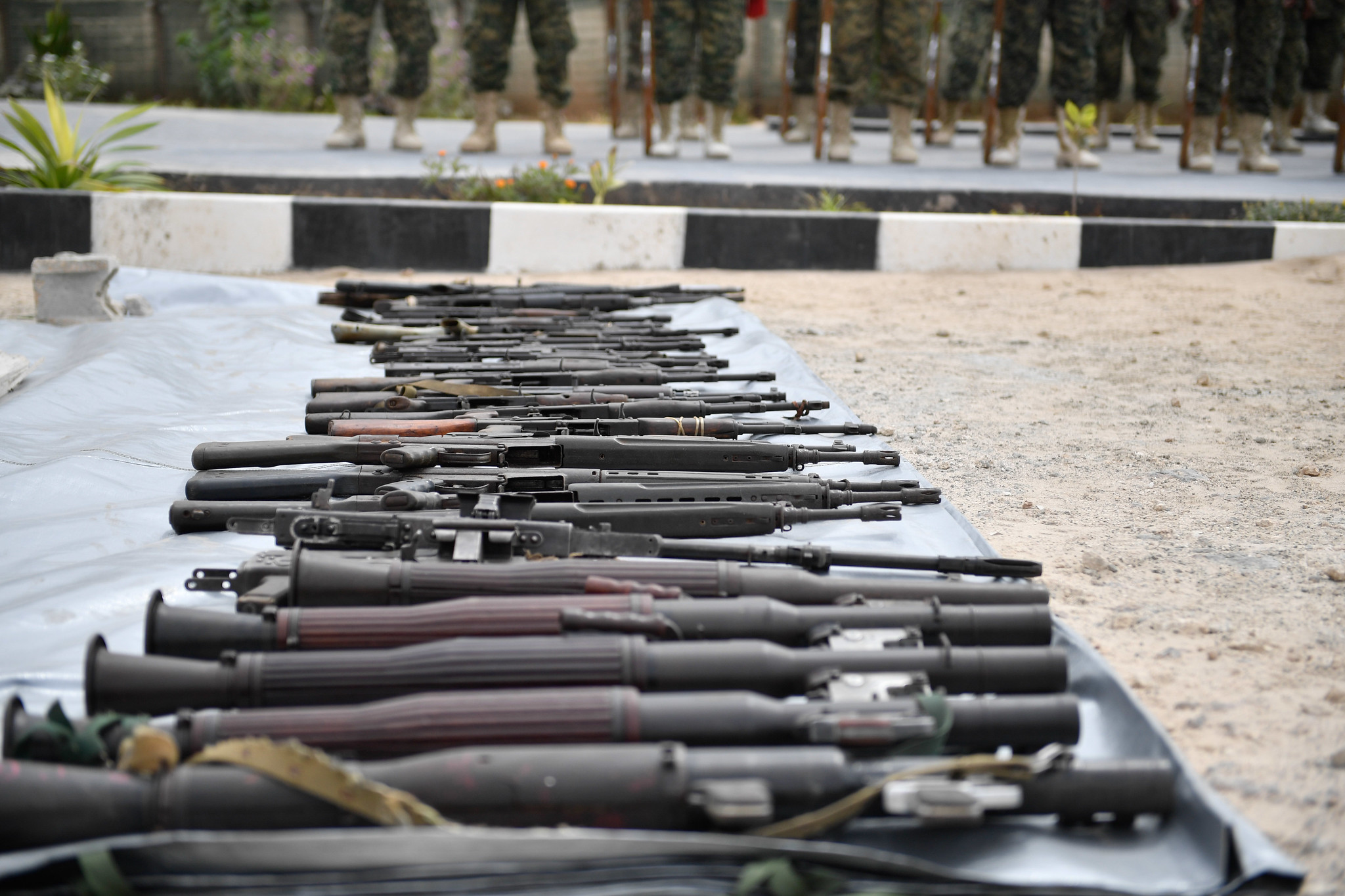
Weapons captured by AMISOM forces from al Shabaab.
“The acquisition of weapons, ammunition, explosives, and other lethal capacity remains a priority for [al Shabaab] but is poorly understood as a system essential to the effectiveness of the insurgency.”
The Somali government and AMISOM have been unable to defeat al Shabaab in large part due to the terrorist group’s ability to procure weapons. According to the accompanying excerpted report from a Somali organization that studies security issues, the Hiraal Institute, al Shabaab annually spends approximately $24 million acquiring weapons through several sources. These sources include arms directly purchased by the group, including from corrupt government officials; those bought from dealers who frequently sell lethal wares from Yemen; and various small arms obtained in Somali black markets. Al Shabaab spends an additional $1.8 million per year on its in-house explosives and weapons manufacturing activities, with much of that money used to obtain chemical precursors to explosives.
Though al Shabaab is sometimes depicted as having internal divisions and problems, acquisition of these weapons as described by the report hardly appears haphazard. Instead, consultative bodies and so-called ministries play a large role in properly arming the terrorist organization’s members. Most important for regular arms procurement is the organization’s defense ministry, which receives a substantial monthly allotment of funds.
Al Shabaab’s security committee, which draws from both the military command and executive leadership, makes the decisions for acquiring large amounts of equipment in preparation for an increased operational tempo, or for purchasing very expensive individual items. Al Shabaab’s finance ministry is responsible for acquiring the funds necessary for these weapons purchases mainly through illicit taxation. The report notes that the farmers, merchants, and others who are barely eking out a living are being extorted so that the terrorists can purchase more weapons which can be used to extort and hurt these people further. Though the finance ministry’s methods can be quite brutal, they are also quite profitable, enabling continued weapons proliferation in a country already awash in arms from decades of inter-clan warfare. The ready availability of so many weapons, especially in the hands of al Shabaab, has made the pursuit of peace, security, and stability by the Somali National Army and AMISOM, and the Western powers backing such efforts, extremely difficult.
Source:
“Al Shabaab’s Arsenal; From Taxes to Terror,” Hiraal Institute (Somali organization that studies security issues), February 2022. https://hiraalinstitute.so/wp-content/uploads/2022/02/Al-Shabaabs-Arsenal-From-Taxes-to-Terror-Web.pdf
The situation in Somalia is increasingly one of stalemate, with little prospect of either the Federal Government of Somalia (FGS) with AMISOM and international support, or al Shabaab (AS) delivering a decisive military victory. However, AS remains adaptive and in control of large parts of Somalia, in particular in the south, with partial control over other areas. It is clear that AS has access to several sources to acquire weapons. The acquisition of weapons, ammunition, explosives, and other lethal capacity remains a priority for AS but is poorly understood as a system essential to the effectiveness of the insurgency. In October 2021, the Hiraal Institute undertook a four-month project to research the scope, scale, system, and use of AS resources to obtain lethal materiel, both in Somalia and from outside.
… It needs to be emphasised that all of AS’s actions within the security field – including arms procurement, capability acquisition, and distribution – are enabled by the extensive finance operations that the group undertakes, notably its illicit taxation collection and revenue gathering. In essence, the money that AS gathers illegally from those it forces to pay tax in Somalia funds the ability of the group to purchase weapons, arms, and ammunition that it then uses in its operations and attacks in the country.
Within Somalia, AS operates a hierarchical financial administrative structure. A central Finance Maktab headquarters oversees a financial centre under which provincial financial centres (one per AS designated province) operate. Funds are moved through regular AS financial channels, utilising a number of methods and in a corresponding variety of forms – cash, bank accounts and mobile money transfer, and hawala – to channel funds to where they are intended.
While Somalia and Yemen are largely excluded from the international banking system, the use of banks for transfers of illicit payments within Somalia is commonplace; again, reporting states that transactions are made via accounts in the name of friendly legitimate businesses or individuals.
Image Information:
Image: Weapons captured by AMISOM forces from al Shabaab
Source: Omar Abdisalan/AMISOM/flickr, https://www.flickr.com/photos/au_unistphotostream/49590723103
Attribution: Public Domain
